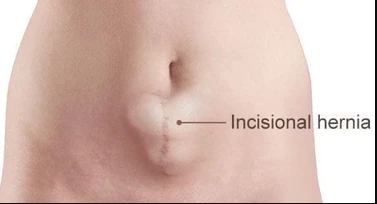Incisional hernia forms at the site of an abdominal surgical incision, most commonly around three to six months after surgery. Nevertheless, an incisional hernia can occur years after surgery, because the incision site—or the scar— becomes a weak link in the abdominal tissue, pretty much forever. Especially in cases where the site has been used for multiple surgeries, patients are at risk for developing hernias. Add weight gain, pregnancy, heavy lifting or any other kind of regular inter-abdominal force to the equation and you’ve got a recipe for a hernia in the making.

Essentially what happens is that the scar site in the abdomen wall pops open, and through it pops out some piece of an organ or fat. The smaller the opening, the more painful the hernia typically is, because the nerves get pressed upon more acutely. When tiny ventral hernias (hernias anywhere in the abdomen) occur in women, they are generally a lot harder to diagnose than they are in men. This is partly because they can be so small and internally located, that a doctor can’t readily see or feel them. But they are also harder to diagnose because the burning sensations women tend to feel from very small hernias often seem to suggest other gynecological issues. In a nutshell, a hernia that can’t be seen or felt is not regarded as a likely culprit for an otherwise healthy woman…until an MRI shows otherwise, and that’s if a patient has an MRI.
While The Tupler Technique® can’t heal an incisional hernia (sorry—you’re going to have to resort to surgery for that), it can stop it from occurring in the first place. And mastering The Tupler Technique® prior to hernia or other abdominal surgery can prevent you from busting your stitches afterwards, which happens more often than you’d think. In fact, if you have surgery to heal an umbilical hernia but you don’t heal your diastasis—you can put money on the chances that the hernia is going to come back.
You can prevent an incisional hernia by strengthening before surgery. Women who do the Tupler Technique® Program during their pregnancy and end up having a C-section, have an easier and a more effective recovery because of this abdominal preparation. You can also avoid adhesions by doing scar mobilization and organ mobilization after surgery.
To learn more about Diastasis Recti & the Tupler Technique® read this article: DIASTASIS RECTI RESEARCH AND EVIDENCED BASED EXERCISE PROGRAM
To view my programs click this link: Save on Packages
Watch the short video below to know what a diastasis is.




2 comments
Ремесло – это когда вы создаёте не для продажи, а для радости https://artisanalcrafts.ru/
This is a really god tip especially to those fresh to the blogosphere.
Short but very accurate info… Thank you forr sharin this one.
A must read post! https://www.waste-ndc.pro/community/profile/tressa79906983/